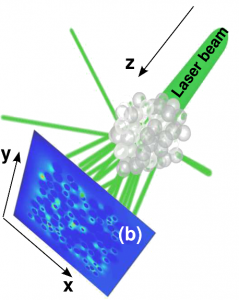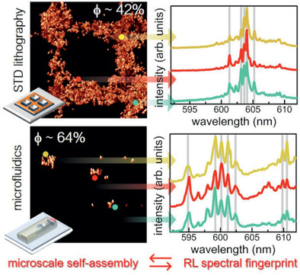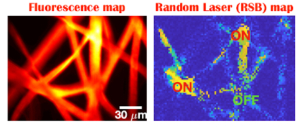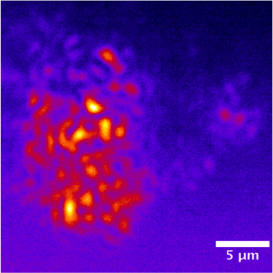A paradigmatic example of complexity in photonics is offered by the propagation of a light beam in a disordered, linear or nonlinear, media. In this framework, our interest is focused on both understanding the complex physical process behind the scenario of the observable phenomena and the exploitation of disorder to develop disordered-based optical devices, like novel laser sources and tools for optical manipulation and diagnostic.
When electromagnetic radiation travels through a scattering medium, depending on the competition between the length scales involved in the propagation process, i.e., the wavelength, the length scale of the system structure, the photons transport mean free path, ℓ, and the dimensionality of the whole system, a transition from a diffusive propagation regime to light localization can be supported.
The comprehension of the physical mechanisms behind is of paramount importance in terms of fundamental research and possible application as demonstrated by our results in this field.
RANDOM LASER
Random lasers (RLs) are photonic devices whose lasing feedback is based on the multiple scattering of light by disordered structures included into an optically active medium. The spectral features of an RL arise from the delicate balance between the optical gain and the scattering efficiency of the disordered matrix. We fabricate and do experiments on miniaturized random lasers to study the behavior of light entrapped at micron-scale and to propose novel photon deviceS.
Random Laser Spectral Fingerprinting of Lithographed Microstructures
Advanced Materials Technologies, 2001037 (2021)
Coherent random lasers (RLs) originate from the resonant amplification of the light scattered by disordered media resulting in spiky emission spectra with well-defined spectral signatures. Here coherent RL emission is proposed as a tool for identifying the spectral fingerprint of porous micro-structured materials obtained by soft lithography techniques. The close control of the spatial patterns and structural characteristics of the scattering elements enable us to obtain stable and unique RL spectra distinctive of each lithographed device. The spectral emission has been thoroughly analyzed with respect to the morphology of the devices in terms of surface roughness and surface volume fraction, demonstrating that the packing of the scattering particles is the main factor in determining a RL emission characterized by multiple linewidths with a high level of coherence. The findings provide novel insights for the realization of miniaturized photonic devices with selectable optical features.
Heterogeneous Random Laser with Switching Activity Visualized by Replica Symmetry Breaking Maps
LM Massaro, S Gentilini, A Portone, A Camposeo, D Pisignano, C Conti, et al.
ACS Photonics 8 (1), 376–383 (2021)
In the past decade, complex networks of light emitters are proposed as novel platforms for photonic circuits and lab-on-chip active devices. Lasing networks made by connected multiple gain components and graphs of nanoscale random lasers (RLs) obtained from complex meshes of polymeric nanofibers are successful prototypes. However, in the reported research, mainly collective emission from a whole network of resonators is investigated, and only in a few cases, the emission from single points showing, although homogeneous and broad, spatial emission. In all cases, simultaneous activation of the miniaturized lasers is observed. Here, differently, we realize heterogeneous random lasers made of ribbon-like and highly porous fibers with evident RL action from separated micrometric domains that alternatively switch on and off by tuning the pumping light intensity. We visualize this novel effect by building for the first time replica symmetry breaking (RSB) maps of the emitting fibers with 2 μm spatial resolution. In addition, we calculate the spatial correlations of the laser regions showing clearly an average extension of 50 μm. The observed blinking effect is due to mode interaction along light-guiding fibers and opens new avenues in the fabrication of flexible photonic networks with specific and adaptable activity.
Biomimetic random lasers with tunable spatial and temporal coherence
N Ghofraniha, L La Volpe, D Van Opdenbosch, C Zollfrank, C Conti
Advanced Optical Materials 4 (12), 1998-2003 (2016)
Biologically inspired photonic structures are the key for technological advances and for miniaturized lasers. Here random lasers in dye-doped titania with the disordered structure of paper are proposed. Sharp electromagnetic resonances with unexpected broad spatial extension are reported. The modes interact and compete on wide length scales, enabling to control precisely the device performance by acting on the pumping.
Click here to add your own text




